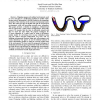Free Online Productivity Tools
i2Speak
i2Symbol
i2OCR
iTex2Img
iWeb2Print
iWeb2Shot
i2Type
iPdf2Split
iPdf2Merge
i2Bopomofo
i2Arabic
i2Style
i2Image
i2PDF
iLatex2Rtf
Sci2ools
ICRA
2009
IEEE
2009
IEEE
Mapping opaque and confined environments using proprioception
Mapping opaque and confined environments such as caves and pipes is a challenging problem for mobile robots because sensor information is severely limited to the immediate proximity of the robot due to the extreme environmental conditions. The robot must also be flexible and agile in unstructured environments while still providing accurate pose estimation. This paper presents a solution to mapping a 2-dimensional tube by using only a snake robot's proprioceptive joint angle sensors. We assume that the tube is sufficiently smooth and that we know the tube width. We propose techniques for (1) pose estimation of a snake robot by using a self-posture motion model, (2) correcting error in pose estimation using only the snake's internal configuration over time, and (3) building environmental features using only self-occupancy and contact detection. Our goal is to use the minimal amount of sensor information possible to build an accurate spatial map of the environment. We have teste...
ICRA 2009 | Robot | Robotics | Snake Robot | Tube |
| Added | 19 Feb 2011 |
| Updated | 19 Feb 2011 |
| Type | Journal |
| Year | 2009 |
| Where | ICRA |
| Authors | Jacob Everist, Wei-Min Shen |
Comments (0)

